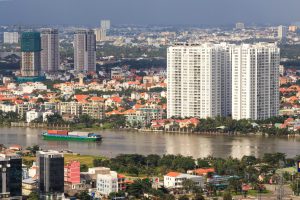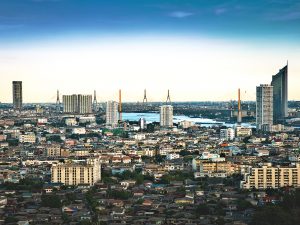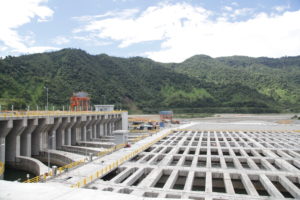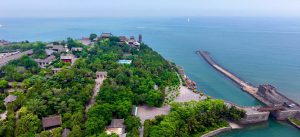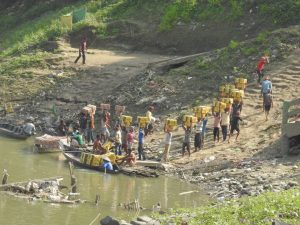Sleepy Song Khoai commune in Quang Ninh province, which borders China, is shaping up to be a test location for Vietnam’s growth strategy, and a focal point in a swirling debate about its response to the US-China trade dispute.
Once, Song Khoai’s only distinction was its position on the road to the tourist magnet of Ha Long Bay, famous for its nearly 2,000 islands. However, in late 2018, work began on the US$156 million Song Khoai Industrial Park, which its developer says will bring in foreign investment and eventually create up to 300,000 jobs.
The Thai developer, Amata Group, is betting US-China trade frictions will help fill Song Khoai’s factory units when the first phase opens in 2020. Manufacturers, including Chinese ones, are seeking to avoid punitive tariffs.
“One of our targets is Chinese and foreign investors who can’t base in China as a result of higher manufacturing costs and the trade war,” said Somhatai Panichewa, who is CEO of Amata VN Public Company Limited, a subsidiary.
Economic winner
Vietnam has been by far the biggest winner from the first year of the trade war, according to a June report from economists at Japanese investment bank Nomura.
The US president, Donald Trump, slapped additional tariffs of up to 25% on China-made goods in mid-2018, and Beijing reciprocated.
Nomura’s economists compared monthly trade data with official tariff lists and found that both US- and China-based firms have cut back imports of certain goods from each other to avoid higher tariffs and are sourcing those goods elsewhere – especially from Vietnam.
Such trade diversions accounted for an estimated 7.9% of Vietnam’s gross domestic product in the year to March 2019, according to Nomura.
Opportunity
Vietnamese prime minister, Nguyen Xuan Phuc, told Bloomberg early this year that his country is “ready to grab the opportunity” from the trade war – as it answers the goals of the government’s economic liberalisation policy, which envisages rapid growth from export-oriented and foreign-led investment.
Chinese investment is a major contributor, providing 6.8% of all foreign direct investment (FDI) in 2018, according to Vietnamese government data. Chinese investment is concentrated in the construction, manufacturing and energy sectors and has grown from US$700 million in 2011 to over US$2.4 billion in 2018. China is now Vietnam’s fifth-largest investor after Japan, South Korea and Singapore.
The trade war is expected to accelerate the growth in FDI from Chinese companies.
Shortly after the trade war began, 16 Chinese companies – many of them electronic device manufacturers – relocated to the China-Vietnam (Shenzhen-Haiphong) Economic and Trade Cooperation Zone in northern Vietnam, the only Chinese state-owned industrial park in the country.
As well this kind of manoeuvre, the trade war has brought fraud and tax evasion too. In June, Vietnamese customs officers found fraudulent certificates of origin, and illegal transfers of goods ranging from agricultural products and textiles to steel and aluminium. Although it’s difficult to assess the scale of such frauds, they must account for a portion of the country’s recent surge in exports to the US.
Nonetheless, Vietnam’s economy is doing well overall thanks to the influx of FDI, political stability and low labour costs. The economy grew by 7.08% in 2018, its fastest rate in 11 years, according to government figures quoted in state-run media.
Manufacturing was the strongest driver of growth, expanding 12.98%, while taken together industry and construction expanded by 8.85% and made a 48.6% contribution to overall growth. Mining declined for the third year in a row, while agriculture grew as a result of restructuring.
The World Bank’s December 2018 forecast said Vietnam would grow 6.8% in 2018, beating overall emerging markets growth of 6.3% in the East Asia and Pacific region.
Downplaying diplomatic tensions
Such rosy business prospects were barely imagined back in 2014 when anti-China demonstrations targeted China’s deployment of an oil rig in disputed waters in the South China Sea. The protestors damaged several Chinese-owned factories in Bình Dung and Dong Nai provinces.
The government’s priority is political stability, to reassure businesses and investors and secure growth, in the view of Nguyen Thanh Trung, an international relations scholar in the University of Social Sciences and Humanities within Vietnam National University.
“Hanoi attempts to separate the South China Sea from their economic ties with China as much as possible. If not possible, they try to put it to the backburner” he said, of the diplomatic and military tensions surrounding offshore islands that are claimed by five countries.
But experts warn that there will be longer-term challenges to Vietnam’s sustainable growth if the current “trade war boom” produces over-reliance on the export sector and foreign investment.
A study from the Singapore-based ISEAS Yusof Ishak Institute points to the more immediate risk that all Vietnam’s goods could suffer higher US tariffs due to Chinese goods being rerouted through Vietnam, labelled as “made in Vietnam”, and exported to the US.
Importing dirty industries
There is also the risk that Chinese firms will relocate outdated and polluting technologies to Vietnam, causing environmental stress and damage.
Public fears were raised – expressed at the time in racial sentiments against ethnic Chinese – when mass fish die offs took places in central Vietnam’s coastal provinces in 2016. The disaster was caused by Taiwan-owned Formosa Ha Tinh Steel, which discharged toxic industrial waste into the ocean.
Seafood is one of Vietnam’s major exports. The Association of Seafood Exporters and Producers expects that demand for Vietnam’s output will rise because of the US and China’s tariffs on each other’s products.
Bac Lieu province in the Mekong Delta is a shrimp farming region where growing international demand for Vietnamese shrimp has resulted in the expansion of intensive shrimp farming and the loss of mangrove forest.
Shrimp farm owner Tran Thanh Phong said that the main markets are the US, China and Europe. He described Chinese dealers he has met as “easy buyers” who do not pay strict attention to quality and standards.
Some experts believe Vietnam will need more regulatory reforms to limit the environmental impact of low-cost business and manufacturing.
They include Le Anh Tuan, deputy director at the Research Institute for Climate Change, Can Tho University, who monitors the environmental impacts of development and thinks Vietnam has to think of different, more beneficial approaches to growth, partly “to reduce the risks of this trade war”.
Green and skilled
In a recent article in the Hong Kong-based South China Morning Post, Lam Thanh Ha, a senior lecturer at the Diplomatic Academy of Vietnam’s Ministry of Foreign Affairs, wrote: “Vietnam will need to move up the value chain. It must find ways of attracting hi-tech industries, environmentally friendly firms, clean energy, as well as advanced medical equipment and health care services.”
Vietnam is following the export-led economic growth model adopted by several successful New Industry Countries (NICs), such as Thailand and South Korea. It relies on strong inflows of foreign investment coupled with productivity growth, largely in heavy industry, chemicals and other sectors with intensive use of natural resources.
This model causes environmental and social strains and promotes labour-intensive industries that can skew or suppress the development of skilled labour creating eventual barriers to long-term growth.
South Korea has evaded this development trap by focusing on high-tech industries and ramping up research and development programmes in the early 2000s, whereas Thailand finds itself still clinging to high-risk manufacturing and imported technology.
Vietnam risks missing out by focusing too much on short-term benefits and easy wins.
“If Vietnam focuses on improving its labour skills and human resource capacity, it can go beyond where it is,” said Chayanee Chawanote, a lecturer at Faculty of Economics, Thammasat University in Bangkok, Thailand, pointing to the fact that most managerial posts in Vietnam are currently filled by foreigners.
Amata Group’s Somhatai was more upbeat, and promised that the 714-hectare Song Khoai industrial park will be a green development: “We plan to be here in the long run so we want to do the business right.”
She believes building more infrastructure has a role to play in redistributing development benefits across the country, as railways and deep-sea ports will increase investment opportunities. Green technology and renewable energy are potential sectors that will generate long-term growth.
“There’s plenty of scope for growth within a sustainable framework,” she said.
This story is produced in collaboration with The Mekong Eye, a media resource for sustainable development, a project of Internews’ Earth Journalism Network.

